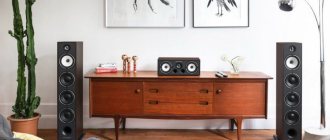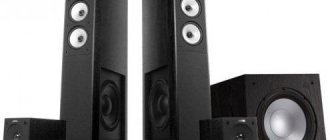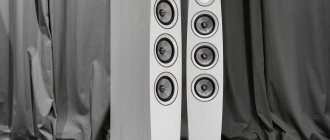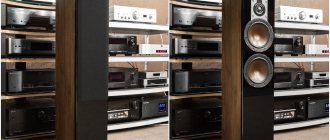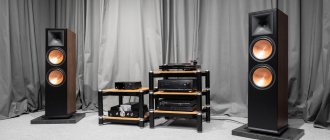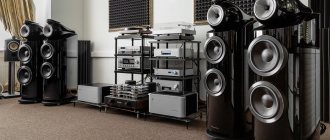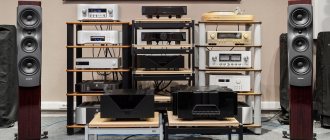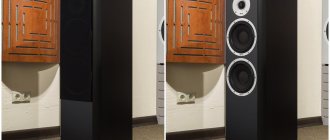The brand manager of one of the companies once told me in an interview that there is no British, German, or American sound, otherwise all equipment from these countries, regardless of the manufacturer, would sound the same - but this is not so. On the other hand, it is clear that equipment manufacturers’ ideas about good sound are influenced by the culture in which they grew up, the music they listened to, the world that surrounded them. And it will not be possible to completely eliminate the influence of the environment.
Yes, it is impossible to achieve absolute identity in the sound of different brands born in the same country, but some characteristic features may slip through. This, in fact, is rather a topic for some kind of socio-cultural research, but it is quite appropriate to begin a text with these words about the Triangle brand, undeservedly forgotten on the Russian market - because this is a French technique with its own special style.
Triangle acoustics have been familiar to the average audiophile for a long time, but somewhere in the background. The brand does not always come up in discussions, although it would seem that it is nearby. And, by the way, it is worthy of discussion. We got a model from the Borea series for testing - the next after the initial Plaisir and the line of active acoustics. Moreover, the model went to the flagship, BR09.
These floor stands are of fairly standard proportions - narrow columns just over a meter high. The black version with a rough, matte black front panel and textured vinyl sides looks strict but elegant.
There is a gap between the front panel and the rest of the body, quite a big one, which makes it seem as if the front panel is floating apart from the body. The acoustics stand on a wide, fairly thick pedestal, and stand confidently.
The front panel is covered by a protective grille with magnetic fastenings - and believe me, not every high-end brand has protective grilles made so carefully. No glue drips or acoustically transparent fabric sticking out, nothing like that - it’s very nice to see such a high-quality finish in a budget line. Thanks to the inward beveled edges of the grille, it is very easy to pick up and remove with your fingers, and a pair of horizontal spacers add rigidity to the structure.
The speakers have a three-way configuration, and low frequencies are handled by as many as three 16-cm speakers loaded onto a bass reflex port located on the front panel. Each speaker is framed in a ring with cut-off sides, decorated with thin silver semicircles. The same pattern frames the tweeter - it is cut into the horn material along with the Triangle logo.
This small and seemingly meaningless design element, oddly enough, is endearing. He collects all the diversity of speakers into a single ensemble, maybe even convinces that yes, these speakers are created to work together and will not interfere with each other.
With the grills removed, the acoustics look very nice - both in terms of proportions, and in terms of shades, and in terms of finishing. The large bass reflex port with recesses, located at the very bottom, practically coincides in diameter with the dustproof caps of the low-frequency drivers, which makes it seem like a continuation of the line of emitters and does not stand out from the overall picture. The Triangle logo supporting it from below, slightly silver, is not noticeable and does not interfere at all.
The design came out harmonious, albeit simple - but, it seems to me, the white version still looks more interesting.
Inside the case
The woofers are made of fiberglass, a tough, strong material that allows the speakers to play quickly, and are complemented by large dust caps. Large magnets also pursue the same goal: the lows do not linger for long and do not spill, adding turbidity to other ranges.
The middle is played by a separate speaker of the same caliber as the woofers, but with a completely different configuration. It migrated to the Borea series from the older Esprit Ez line: it has a shining white diffuser of a carefully calculated shape made of pure cellulose without any additional coating and a sharp phase-equalizing bullet. A special suspension profile, with a small fold, is the company’s proprietary technology: the speaker does not have a very large amplitude of movement, but due to the correctly selected combination of rigidity and compliance, as they say in the description, vocals sound very realistic.
The soft silk dome tweeter is slightly recessed into a small horn and is complemented by a silver EFS phase-equalizing pad, reminiscent of a bridge whose middle has been destroyed. Both the horn and the pad are designed to improve dispersion and reduce distortion.
But the most interesting thing happens inside the case: there is a proprietary strut system called DVAS. It primarily tries to keep excess vibrations from the woofers in check, absorbing them with the help of perforated MDF panels and EVA foam inserts. The speaker touches the spacers through an EVA pad installed directly behind the magnet, due to which most of the vibrations are dissipated in the spacers and only a small part is transferred to the body.
On the back wall, by the way, there is nothing interesting at all: the bass reflex is brought forward, and the switching is very simple - just a couple of massive, heavy metal terminals. So you will have to do without biamping.
All technologies in the series are designed to achieve maximum neutrality, realism and purity in sound - and here we return to the fact that each manufacturer interprets these concepts differently.
The concentrate of all the love in this world
It is recommended to install the acoustics 40 cm from the wall, despite the bass reflex placed forward, with a slight turn inward, at a distance of at least two meters from each other - nevertheless, the acoustics are not the smallest and, according to the manufacturer, are suitable for rooms up to 30 m².
For us, Borea BR09 stood in a small room and played with a small system based on Pro-Ject technology - with a MaiA S2 amplifier and a StreamBox S2 Ultra network source. And it’s even surprising that such compact devices were able to cope perfectly with floor-standing devices, giving both control and cleanliness.
Three bass drivers and promises of unprecedented harshness immediately put you in a playful mood and you want to hit with something richer, but reality has made adjustments: if you take, for example, the albums “BBNG” and “III” from BadBadNotGood, then you shouldn’t expect thick bass from Triangle. The bottom is delicate, tactile in a good way, but not at all stuffy or loud. It is a little soft and dry, it seems to love plastic more than kick drum, and it copes well with a drawn-out jazz-hop beat - carefully, without trying to fill the entire space with massive bass.
But in these albums, all the attention from the lower parts is transferred to the impossible beauty of the iridescent piano - crystal, sparkling, ringing and at the same time tender. This is a completely ephemeral grace, sprinkled with light sadness where sadness usually makes it difficult to crowd through. The sound is not just airy, it seems to be additionally ozonized - fresh, like a clearing after a rainstorm.
This emphasis on high frequencies is definitely there, but it is presented so gracefully and bewitchingly that it does not cause either negativity or fatigue - on the contrary, in combination with the upper register of the piano it has an almost hypnotic effect, which I was not able to catch with synthetic samples. There are a lot of details at high frequencies, you can - and even want - to swim in them, like in a cool lake in the summer, scooping with your hands. True, the crunchy recording defect in my version of “Hedron” still attracted too much attention precisely because of this accent and interfered more than before, so the quality of the music played should be treated wisely.
The sound is some kind of abyss of emotions, life, maybe even with some kind of eclecticism. The acoustics convey feelings at the ends of the spectrum well - they manage both the aggression of the same Prodigy, and, conversely, some completely unreal tenderness, softness and sadness in the slow tracks of DJ Shadow and Imogen Heap.
With Borea BR09, music is not just a parade of beauties brought to the fore. It seems that acoustics is trying to understand the aesthetics of sound, and it is able to find it even in the noise of industrial music and the rumble of a djent barrel. True, she sees her own aesthetics, which is completely special.
Listening to Nine Inch Nails on these speakers is an experience like no other. This acoustics turns any music into a holiday, and even the apocalypse in the most depressing melodies is greeted with joy. Both versions of “The Day The World Went Away” seemed to be accompanied by bright fireworks and balloons instead of a mental atomic mushroom, and in “All The Love In The World” the offended and tired accusations were replaced by completely open flirtation. I didn’t even think that Reznor’s tracks could play like that - that all the power and pain in them could be converted into something just as huge in power, but directed in a completely different direction. An indescribable feeling that really breaks the brain.
All emotions are located on the stage, stretched upward - although the room may have played a role here. The images spin around in calculated chaos on a well-defined hemisphere, without colliding with each other, but the scene could have been larger in width. Sometimes there is a lack of depth and the images seem a little flattened - but what the speakers lack in volume, they more than make up for in sensuality.
There is a lot of music. And it seems that it’s much more pleasant for acoustics to play loudly: the emotionality reaches some tangible level. Female vocals turn into spells - sensual, deep, penetrating into the very soul. The winds gain textural expressiveness.
And the same Prodigy, with all kinds of drum and bass, play as freely and uninhibited as possible - and the melodies do not fall into a crazy and thoughtless patter, but remain alive, multi-layered, accurate. In a heap of samples you can almost always catch one and watch how it flows into others. The bass remains clear, perky, correctly dosing sharpness, boom and comfort, mixing them in the most cheerful proportion without a drop of negativity.
And that's the whole point of the Borea BR09: the acoustics try to find a balance between the completely physical sensation of the music and the emotional response from it, and the latter regularly outweighs. These columns are about images and feelings first and foremost. They are not for analysis, although they are quite detailed.
Speaker systems Triangle Borea BR03
The Borea line from the famous French brand received an award from the EISA association - “Best Buy Home Theater Speaker System 2020 - 2021”. Home movies are good, but sometimes you want to listen to music on the same acoustics. We will test the budget bookshelf BR03 with three different amplifiers and try to get the most out of them that they are capable of. After all, a manufacturer cannot necessarily be judged by its most expensive models.
Indeed, with a strictly limited budget it is more difficult to make a good thing, and this is where the real skill of the developers is demonstrated. Here there is a struggle for the buyer, who counts every penny, and the winner is the most experienced one, who is able to invest a little more in the project for the same money than his competitors.
Triangle has 40 years of successful experience in the hi-fi industry, and several speaker models such as the Altair, Magellan and Signature have become clear examples of a non-standard approach to speaker design. The company's curriculum vittae states that its products are developed by people who are seriously passionate about music and its reproduction. This is also important in our business - pure engineering skill is good, but when it is combined with love for one’s own work...
The term Best Buy in the Borea award abstract means “Best Buy”, i.e. implies an attractive price-quality ratio. First, let's get acquainted with the quality of design and execution.
Three “extra” decibels means a doubling of sound pressure with the same input power, and this significantly expands the possibilities when choosing an amplifier.
The Borea line is notable because it is new, while Triangle does not tend to regularly update its range, and many series have been successfully produced for over a decade. The BR03 itself is a classic two-way model, second from the bottom in its budget line. It, in turn, is interesting for its sensitivity of 90 dB, although the typical value for monitors of this size is 87 - 88 dB. Three “extra” decibels means a doubling of sound pressure with the same input power, and this significantly expands the possibilities when choosing an amplifier. So when we listened, we tried three different options, but more on that later.
The second interesting feature of the BR03 is the new tweeter design, developed specifically for the Borea series. An inch silk dome is placed in a short waveguide, essentially a mini-horn, forming the desired radiation pattern. An original EFS (Efficient Flow System) phase-equalizing element in the form of two vertical “arrows” is installed in front of the dome. They eliminate dips in the frequency response that arise due to the interference of sound waves emitted by the central and peripheral sections of the dome. The magnetic system is neodymium, which, in combination with the horn, led to the high sensitivity of the tweeter.
An original EFS (Efficient Flow System) phase-equalizing element in the form of two vertical “arrows” is installed in front of the dome.
The design of the midrange drivers was borrowed from the Triangle Esprit Ez line. The geometry of the lightweight 16cm raw cellulose cones has been optimized to eliminate local resonances and resulting sound coloration. In the center is a phase-equalizing “bullet,” an element rarely found in budget-class acoustics. The wide elastic suspension is designed for large displacements of the moving system. Mid-bass drivers in a bass-reflex design begin to reproduce bass from 46 Hz - this is an honest declared value for such a body volume. So that the monitors can be placed close to the wall (although this is not recommended), the bass reflex ports are located on the front panel.
Nothing is reported about the features of the crossovers; only the crossover frequency is known - 3600 Hz. As a rule, for two-way monitors it does not exceed 2500 - 2700 Hz, but the developers of BR03 clearly tried to make sure that the voice range that is most important for our hearing is reproduced by one speaker.
Borea cases are constructed from MDF with perforated internal panels made of EVA foam, which acts as a vibration absorber.
And finally, recently, models in this series began to be produced in a new fashionable “light oak” finish, and this is natural veneer, not imitation. This style is considered Scandinavian; light furniture is now really popular in the countries of this region. Other options are walnut, black ash, matte white.
BR03 monitors are recommended by the manufacturer for rooms with an area of 15 to 30 m², about 15 were in our listening room.
The first stage of testing is to put vinyl on a Pro-Ject Debut Carbon EVO turntable with a Pro-Ject Phono Box S2 phono stage and a Taga Harmony HTA 1200 hybrid integrated circuit with a power of 2 x 80 W.
Despite the modest dimensions of the case, the monitors are capable of producing fairly high peak levels without difficulty.
The first impression is that the BR03 have an extremely linear tonal balance, but at the same time there is no “monitor” indifference or analytical detachment in their character. They show the recording vividly, moderately bright and detailed. It is the detail inherent in acoustics with paper diffusers that makes the sound not background, but makes you listen to the music and find new nuances on familiar tracks. The tweeters produce a light, voluminous spectrum that harmoniously fits into the overall picture, complementing it with “atmospheric” components. Everything is very smooth, without unnecessary accents, and at the same time beautiful.
Midbass drivers quickly respond to sudden changes in the input signal, so hits are transmitted clearly, with a natural attack. Accordingly, the rhythmic structure of a musical work is correctly built, regardless of its genre. Despite the modest dimensions of the case, the monitors are able to easily produce fairly high peak levels, due to which their overall character is perceived as dynamic and free.
The bass, of course, is not record low, but quite energetic, clear, and well controlled. And, what is important, without unpleasant artifacts - buzzing, muttering, etc. Double bass - every note is literally sculpted, the bass drum hit with decent filling. Yes, it doesn’t hit you in the gut, but it’s quite convincing to the ears.
The bass, of course, is not record low, but quite energetic, clear, and well controlled.
These monitors have another attractive property: tweeters with a proprietary design draw the sound picture very accurately. The location of instruments in the scene, spatial effects, reverberations - all this is shown with a clear reference to a specific place in the sound stage.
The second stage of testing - the source is the same, but the amplifier is purely tube, Taga Harmony TTA 1000. The general character of the presentation is approximately the same, but the dynamics are a little softer, and the timbres of acoustic instruments seem richer, but less clear, as if slightly blurred. But there is more air in the stage, and the old jazz sounds so that it is impossible to tear yourself away.
And finally, the option with the most unexpected result: the Pro-Ject Stream Box S2 streamer with the Pro-Ject DAC Box S2+ DAC as a source and the Pro-Ject Maia S2 miniature amplifier. And this is where the sensitivity and responsiveness of the BR03 came in handy - with the Maia S2 box, the monitors produced simply amazing energy. Plus, there is a well-designed strike, a clear attack and excellent control in the lower register. Since this was a stream, the stage was built somewhat conventionally, the timbres were simplified, but in terms of accuracy and relief, the sound picture turned out to be even better than what was obtained with a vinyl player.
As you can see, Borea BR03 can easily be sung with transistor, tube, and digital amplifiers. And what is especially valuable is that they will become a light burden not only for them, but also for the family budget.
MUSIC
- Nina Hagen, "Nunsexmonrock". CBS, 1982
- Elton John, "Here and There". This Records Co., 1976
- Hot Wishbone Ash. MCA Records, 1981
- Capitol Jazz Classics Vol.4. Capitol Records, 1972
- Her, "Her Live Tape #1". ZRP Records, 2016
SYSTEM
- Pro-Ject Debut Carbon EVO turntable
- Phono stage Pro-Ject Phono Box S2
- Streamer Pro-Ject Stream Box S2
- DAC Pro-Ject DAC Box S2+
- Integrated amplifiers: Taga Harmony HTA 1200, Taga Harmony TTA 1000, Pro-Ject Maia S2
- Cables: Pro-Ject Connect It E phono
- interconnects Ortofon Red
- acoustic Taga Azure 12
- network Tchernov Cable Standard
Triangle Borea BR03
Manufacturer: Triangle Distribution (France)
overton.ru/product/akusticheskaya-sistema-triangle-borea-br03
Configuration: 2 bands, 2 emitters || Acoustic design: bass reflex || Frequency range (+/-3 dB): 46 - 22000 Hz || Nominal/Minimum Resistance: 8/4.2 Ohms || Sensitivity: 90 dB (1 W/1 m) || Crossover frequency: 3600 Hz || Dimensions: 206 x 380 x 314 mm || Finish: walnut, black ash, matt white, light oak || Weight of one piece 6.3 kg || Price per pair: 38,990 .
The editors thank the Moscow Salon HiFi for their assistance in conducting the audition.
share
Tags: TriangleTriangle Borea BR03
